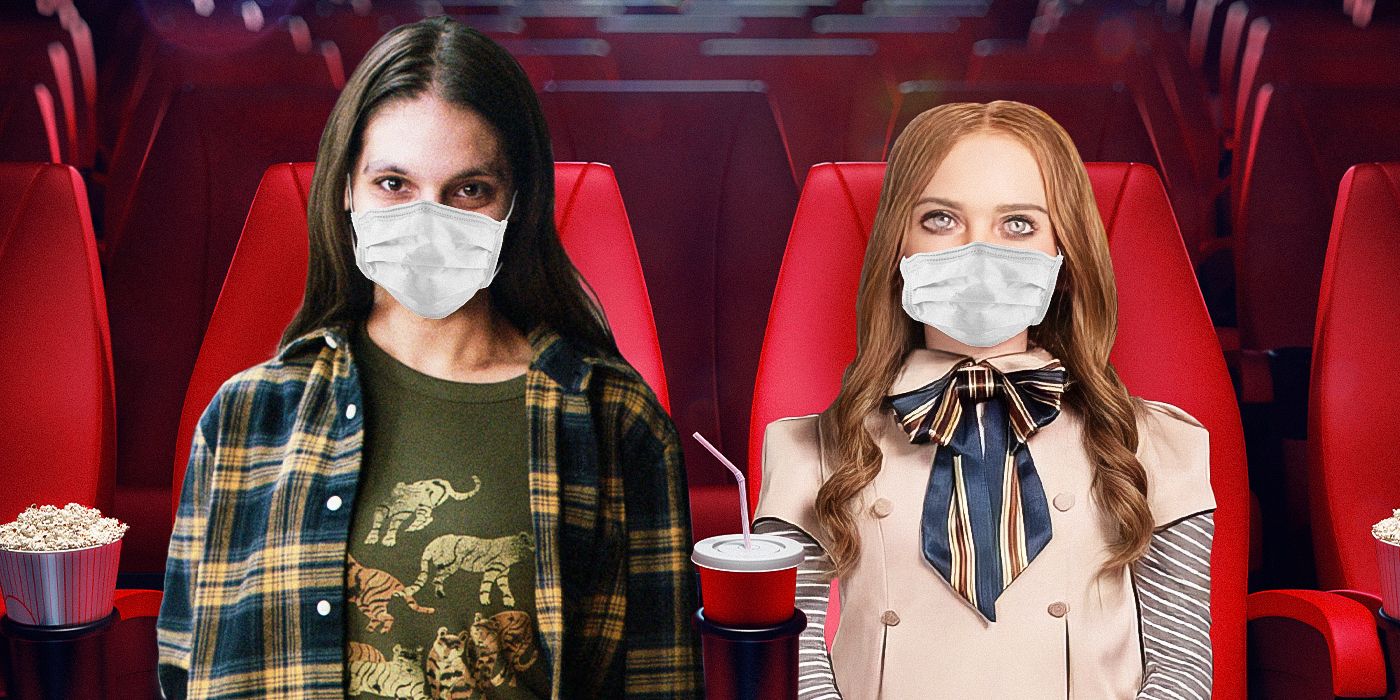The Big Picture
The COVID-19 pandemic has upended everything about the entertainment industry. Combining this ongoing global health crisis with the way massive corporations refuse to pay artists proper wages, instability has gripped the modern world of film. Everybody is looking for a “surefire thing” in the middle of a hurricane of uncertainty. In the middle of all this chaos, one genre has emerged as a rare source of reliable box office success: horror. Scary films have often been a go-to domain for revenue in the history of Hollywood, but the genre has proven especially lucrative in the wake of everything that happened in March 2020.
Since the COVID-19 pandemic launched, superhero films (especially ones anchored by DC Comics characters) have been erratic performers and even long-standing blockbuster franchises like Transformers aren’t as massive internationally as they once were. By contrast, original and franchise horror titles alike are thriving. As seen by projects like The Nun II or Candyman, among many others, audiences are willing to show up for these kinds of projects in droves. This loyalty produces box office numbers that put the global hauls of much costlier blockbuster fare to shame. But how did this happen? How did horror become such a massive deal at the box office in the uncertain world of COVID cinema?
Horror Movies Weren’t Always Box Office Juggernauts
The history of horror movies stretches back to the earliest works of George Melies; this genre has always existed within cinema. For the sake of this piece, though, let’s just limit the scope of horror movie’s box office history to the 21st century. After all, the 2000s were a decade when the genre was in a real slump financially. This decade wasn’t devoid of major hits like Paranormal Activity or the most lucrative Saw sequels, but it was increasingly rare to see horror titles crack $100+ million at the domestic box office. The American film industry had become too reliant on remakes of older or foreign horror titles that ensured some level of pre-release brand recognition from audiences but also limited the appeal of these titles. The 2009 Friday the 13th remake, for instance, fell off a cliff after its opening weekend once the die-hard fans of that franchise showed up to see it. Meanwhile, the increasingly convoluted mythology of the Saw sequels ensured those follow-ups catered to a notable but by no means gargantuan audience.
In 2013, though, one title emerged that suggested just how broadly appealing modern horror could be. The Conjuring dropped in July 2013, a month usually reserved for big blockbusters, and managed to blow away the competition. Exceeding $135 million in North America alone, Hollywood suddenly saw how big horror movies could be. From here, a renaissance, both in terms of quality and box office, for horror features began to brew. 2017 was the moment the box office perception of American horror films really reached the next level, with both Get Out and It reaching $150+ million domestically. The latter project even exceeded $300 million in North America alone, a previously unheard-of haul for an R-rated horror film.
Recent Horror Movies Have Been More Accessible to Wider Audiences
The box office reliability of horror titles in the COVID cinema landscape is building on the financial durability horror movies cultivated just before that pandemic upended everything. After all, just three weeks before indoor theaters shut down across the world, The Invisible Man topped the box office with a sizable haul. An object in motion stays in motion and in this case, that means horror films are just continuing to be major box office players. Since the COVID pandemic began, projects ranging from Smile to Nope to the two most recent Scream installments, among many others, have all brought in massive box office.
RELATED: September Box Office: ‘The Nun II’ Stumps Kenneth Branagh in ‘A Haunting in Venice’s Debut
This wave of lucrative horror movies has flourished thanks to these titles learning from a key flaw in 2000s horror: accessibility. Many recent sleeper hit horror titles have been original projects like Talk to Me, Smile, or Nope that don’t require audiences to remember endless information about Jigsaw’s history to have a good time. Meanwhile, if studios do make a franchise horror title, it’s now a legacy sequel, not a remake. Projects like the 2010 A Nightmare on Elm Street alienated horror geeks for just providing reheated versions of old movies with new actors. Newer projects like the newest Halloween, Evil Dead, and Scream sequels are certainly guilty of repeating the narrative beats of their predecessors. However, making them exist within the continuity of famous pre-existing horror titles makes them feel like reunions with “old friends” to prospective moviegoers rather than the erasure of cornerstones of the world of horror cinema.
Why Is Horror So Popular These Days?
Horror has often flourished at the box office in the middle of global turmoil. These projects can be a way for audiences to process the daunting world outside of the movie theater auditorium they’re sitting in. Just look at Night of the Living Dead and its commitment to such a bleak ending for its Black protagonist, Ben, coming out in the 1960s, an era in which Black civil rights leaders were being assassinated left and right. No wonder this production resonated with moviegoers in that decade. Similarly, in an age of increasingly apparent fascism in American politics and the specter of COVID looming over society writ large, horror movies have become a way for moviegoers to cope with the grisly parts of reality. For two hours, people experience movies that reassure them that the world really is as frightening as it seems while also offering a controlled environment to explore those frightening qualities.
Meanwhile, horror movies are also a rare film genre that streaming services just can’t replicate or even successfully emulate. Streaming horror titles like Run Sweetheart Run, Eli, and others totally exist, but they never leave much of a mark on pop culture. It’s just difficult to mimic the experience of watching a scary feature in the dark in public. There’s a communal quality to horror fare that Netflix and Hulu can’t duplicate. Plus, this genre’s a go-to backdrop for date nights and that event is always more fun to experience out on the town. Without any extra competition from Peacock and Disney+, horror movies on the big screen have been able to thrive with pleasure.
It also doesn’t hurt that studios have been providing theaters and audiences alike with oodles of horror movies. The cheapness of these titles means that everyone from Warner Bros. to A24 to folks with access to Kickstarter can conceivably create a horror feature. The omnipresence of the genre ensures that, by the law of averages, even a handful of these have to be hits. Not every COVID-era horror movie has become a license to print money, just ask summer 2022 features Men or Firestarter. However, box office successes from that same season like Nope and The Black Phone immediately put those earlier duds out of people’s minds. The ubiquity of horror movies in the modern theatrical marketplace ensures that the underperformers quickly vanish from people’s minds.
It also helps that horror in the late 2010s and 2020s has broadened itself up compared to the 2010s. You can do any kind of story in the domain of horror cinema, from Coraline to Cannibal Holocaust. However, the emphasis on torture horror and found-footage fare in the 2000s restricted the genre’s appeal in this era greatly. By contrast, modern horror today has lighter horror/comedies aimed at teens like M3gan, gnarlier R-rated concoctions like Evil Dead Rise, and artsy horror fare like Titane. There’s something for everyone, a microcosm of how cinematic horror storytelling has always had the capacity to inhabit countless forms. This variety ensures that the genre can really have broad box office appeal and that multiple scary films co-exist at the box office at once.
Will This Horror Box Office Revolution Go on Forever?
There are lots of factors informing why horror movies are so popular in the age of post-COVID cinema, but it’s also worth asking if this renaissance can last. Is there any chance horror films will eventually lose their status as a go-to source of box office success? The obvious answer to that is yes. Cinematic trends come and go in waves. Horror cinema has dominated pop culture in previous eras before it once again receded back into the shadows. It’s likely this current fascination with horror movies from the general public will also recede over time.
For now, though, that end date for horror’s box office reliability appears to be far off into the future, especially given how many horror films are on the docket through the end of 2024. Plus, the summer of 2023 reinforced just how popular scary movies continue to be for the general public. Talk to Me surpassed all expectations to become one of the biggest A24 movies in history, The Boogeyman did solid numbers after being upgraded to a theatrical release from its original Hulu destination, and even middling scary fare like Insidious: The Red Door has been packing in audiences in theaters. Frightening films are not currently wavering in their box office durability, especially since so many of them resonate with younger viewers, a key demographic for theatrical moviegoing in the current climate. Folks aged 18-34 aren’t showing up to R-rated comedies in droves, but they are loyally appearing for any new horror movie that drops. To keep that demo happy, Hollywood will no doubt keep the scares coming.
There’s no shortage of problems and questions plaguing the mainstream cinema scene today. This realm can often seem like one dominated exclusively by questions rather than exciting revelations or any sense of calming consistency. The closest thing to reliability that can be found in this domain currently is the box-office stature of horror films. We’ve come a long way from the 2000s when this genre seemed to appeal exclusively to torture horror fans and people who faintly remember that The Hills Have Eyes existed. Now it’s a massive box office juggernaut that Hollywood studios of all shapes and sizes turn to as a rare source of financial stability in tormented times. Who knew figures as creepy as Skinamarink or Jean Jacket could become soothing in any context?
Will this streak last forever? Read More

